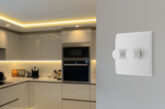
The team at Timeguard looks at the latest developments in PIR detection and advises on the key considerations you should take when making a decision on your choice of product.
PIRs are the swiss army knife of lighting and HVAC control. What could be more obvious than switching according to occupancy? These are devices that should be quick and easy to install if you make the right choices.
The first rule is to choose good quality products, backed by trusted brand guarantees. Once installed in a ceiling these aren’t products you want to be climbing around to replace. Buying from a professional wholesaler is a good start.
Another tip when drawing up your shortlist is to check how the detector is going to be set up and adjusted. Typically, you’ll need to control lux level (so you can avoid nuisance daytime tripping for lights) and time on.
Some also offer range adjustment. Of course, with the best will in the world, later readjustments might be needed, so you may as well be prepared. Are the controls going to be easy to get at? Are they clearly labelled? Are they smooth and accurate to operate?
If you want to control HVAC as well as lighting from one PIR detector, you’ll almost certainly want different settings to give the customer the economy they’re looking for. In this circumstance you should look into two-channel PIRs.
The benefit of a low profile flush mount look is that the controls are hidden behind, so look for good spring clips that will let you remove the unit from an aperture with ease and replace it securely without damaging the ceiling. Or perhaps, if super-sleek profiling isn’t vital, choose devices that offer external access to the controls without compromising on looks. Surface mount can still look modern and stylish!
Or you might prefer ideas like the twist and lock design that enables you to drop the device down and make adjustments. We also have remote control options in our range.
If you’ve got a big area to cover but only need to set up for one time on/lux level combination, think about pre-wired master/slave options. You can get these pre-wired with RJ11 plug-in slave units per master, allowing for quick installation for corridor and multi-zone use.
There are two other key factors to getting it right first time:
1. Ratings
Don’t underestimate what you’ll need. Low wattage GU10 type LED lamps typically have simple circuitry and no surge protection or power factor correction, which means that in-rush currents put a relatively massive strain on a PIR that’s switching/controlling them. It’s a good idea, therefore, to check for a specific high LED rating such as within the Timeguard NightEyeo SLW360N ceiling-mounted and flush-mounted SLFM360NJ detectors.
2. People
Being able to detect people sitting at desks and hardly moving used to be prohibitively expensive, but now presence detection with motion detection should be the standard on any good basic PIR. It adds up to a better user experience – people should hardly notice that there’s PIR control of lighting – they certainly should never be plunged into darkness.
Check the installation guidelines to make sure the core area of the detection field that offers more-sensitive presence detection is big enough for the space you’re fitting out. Bear in mind that the specs of most off-the-shelf PIRs are based on a ceiling height of about 2.5m.
If your client has higher ceilings, check the specification carefully – you’ll find the right options.
Get more details about Timeguard’s PIR range by clicking here








